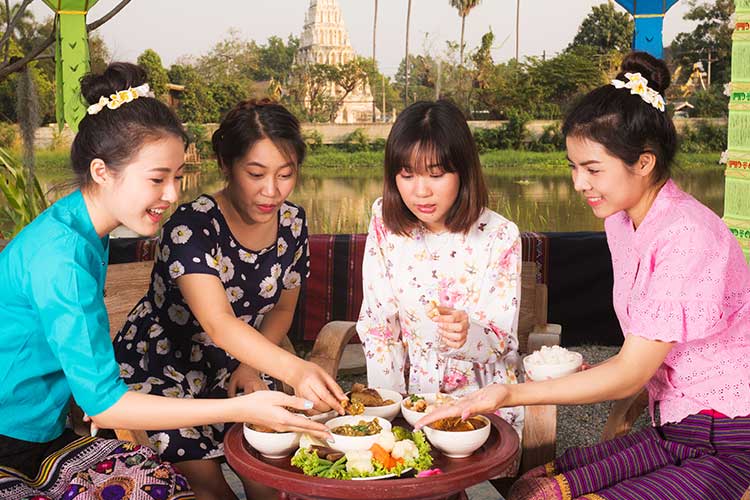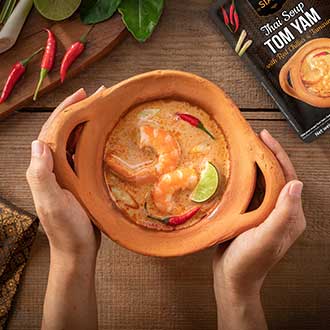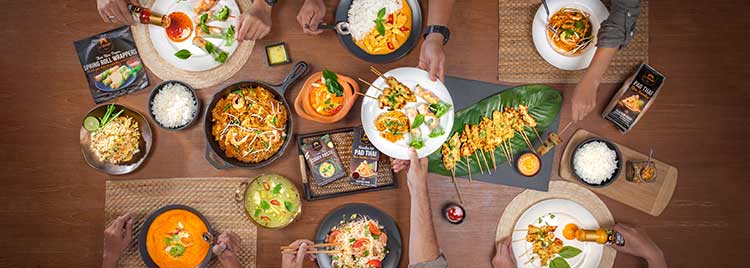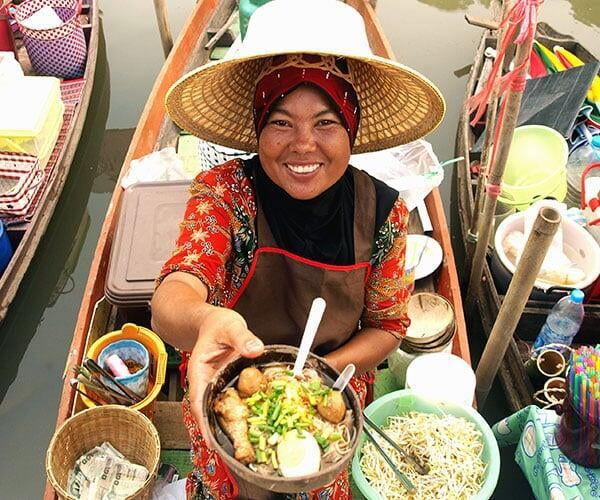My shopping cart
Your cart is currently empty.
Continue Shopping
Thailand has its own table manners like other cultures in the world, but the rules of food etiquette are pretty simple. Learn how to eat like a local with these basic table manners.

Spoons and forks are the main eating utensils in Thailand. In general terms, a spoon is called ‘Chon’ in Thai and a fork is called ‘Som’. In the past, Thai people ate with their hands, then at some point they borrowed the spoon and fork culture from the west and adapted it for use in Thai cuisine. There are a few types of spoons which Thai people use on the table.
The most common one is the table or dinner spoon used for eating rice and main dishes. Some restaurants or some families also use a tablespoon as a serving spoon for shared dishes on the table. A Chinese spoon or soup spoon with a short, thick handle extending directly from a deep, flat bowl is commonly used for soups, or noodles. A teaspoon is regularly used for hot drinks, desserts, snacks and ice cream.
For forks, Thai people use dinner forks for the main dish and cake forks for desserts and snacks. Tablespoons and forks are very useful and can be used to eat most types of Thai food, from rice, stir-fried, soup, curry or Som Tam salad. When eating Thai food, you will hold a spoon in your right hand and the fork in the left (or hold the spoon in your dominant hand and the fork in the other).

The spoon is used to put food into the mouth, while the fork is used to scoop and arrange rice and food onto the spoon so it doesn’t fall off on its way to your mouth.
Thai people mainly eat using the spoon and do not put the fork into their mouths. Thais don’t typically use a knife much whilst eating Thai food as most dishes are served in bite-size pieces so there is no need to use the knife. Most local restaurants serving Thai food do not have steak knives, so if you find a large piece of meat like steamed fish or grilled chicken you can use the edge of your spoon to cut the food into smaller bites.
Typically, Thai people eat sticky rice with their hands, so do not be surprised to see some Thai people next to your tables doing that at a streetside Som Tam shop. But it is good manners to use the spoon and fork especially when you share the meal with other people. When you have finished eating, place the spoon and fork together on the plate.
It doesn’t really matter if you put them at 6.30 or 5.25 or not, it is also quite common for the waiters to check with you before clearing the table.

Chopsticks are called ‘Takiap’ in Thai and are typically used for noodle dishes, Chinese or Japanese food only.
For noodles with soup, chopsticks will be served with a Chinese soup spoon. Hold the chopsticks in your right hand (or dominant hand) and the soup spoon in the other. Use the chopsticks to pick up noodles, meat or vegetables and use the spoon for the broth. You eat directly from the chopsticks or place a small amount of noodles, meat, vegetables and broth in the spoon for eat. It is a good way to mix everything in a perfect bite and a good technique to eat if the food is still too hot and to avoid soup splashes on your clothes.
If you are not familiar with using chopsticks to eat noodles, it is okay to ask for a spoon and fork. When finished, place chopsticks on top of the bowl or on the table, if you leave chopsticks stuck in the bowl, it usually means you haven’t finish eating.

Dish and plate in Thai are the same word: ‘Jaan’. A bowl is called ‘Charm’ or a small bowl is called ‘Tuay’. Tuay is used for sauces, dips or sweet desserts, while Charm is used for soup and noodles.
If you eat with a group or Thai people, you will notice that they like to order a variety of dishes to share. The meal usually consists of spicy and plain food, a combination of salad, stir-fried, soup or curry, or a dip. You will be served an individual plate of rice. Each of the shared dishes should have a separate serving spoon, so you don't have to use the spoon you are eating with. If the meal includes soup or curry dish, you will get a separate set of small bowls and a soup spoon for individual portions as well.
Having a quick meal or à la carte at local restaurants or street food stalls, most dishes will be served with a small bowl of soup for free (except for soup-like dishes). You will also find a variety of condiments on the table, especially at the noodle stalls.
Thai people like to season and spice things up to match their own taste, so the restaurants usually provide condiments like fish sauce, dried chili flakes, chili vinegar and sugar. It is also not rude to do that unless you eat at fine dining or upscale restaurants.

Eat Slowly - Thai people eat slowly and enjoy spending time over meals with friends and families. You do not need to rush, or you will end up having an empty plate while everyone else is still eating. Sometimes not all dishes are served at once, but one after another. So slow down and take time to savor the food and atmosphere.
Don’t Talk with your mouth full – This etiquette is quite universal table etiquette. Chewing with your mouth closed and not talking when your mouth is full.
Wait for the senior to begin eating – In Thailand, age and social status are priority. If you share a meal with your boss or senior person (like your friend’s parents), it is good manners to wait for the highest-ranking or most senior person at the table to start the meal.
Elbows on the Table – It is acceptable to put your elbows on the table in Thailand (even if it is good manners not to do it). But avoid resting your chin in your hand and placing your elbow on the table while talking to other people, especially someone senior than you, this is considered disrespectful in Thailand.
Don’t blow your nose - It is common to have a runny nose after eating spicy food, but don’t blow your nose at the table. Thai people feel it is unhygienic and rude if you do that, so simply wipe it off, a soft, quiet blow is still acceptable.

However, you don’t need to be nervous to make everything perfect, especially if you are travelers or new to the country.
Thai people are relaxed and understand if foreigners cannot follow all their customs, and they are willing to teach you.
If you want to read more about other table customs in Thailand, you can find our article Essential Guide to Thai food culture here.